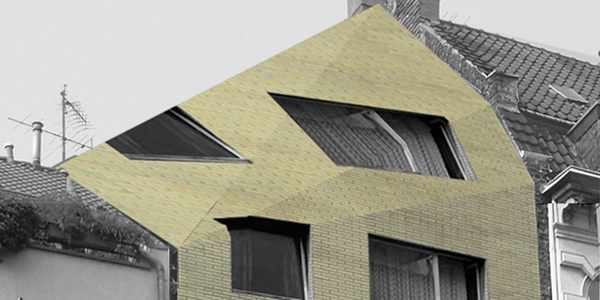
Over the Top – Wo der unmittelbare Sinn aufhört und der Unterschied beginnt
Beim Projekt „Over the Top“ handelt es sich um die Aufstokkung eines Kölner Nachkriegsgebäudes. Interessant ist dabei die Dreiecksform des aus dem alten und dem aufgestockten Dachgeschoss bestehenden Verbindungsteils zwischen den Brandmauern der Nachbarhäuser. Die Parameter dieser Form leiteten sich aus den Strukturen des städtischen Umfelds ab oder ergaben sich aus den gewählten Baumaterialien. Für das neue Geschoss wurden die Fensterformate aus den 1950er Jahren und die Fassadenverkleidung mit Fliesen übernommen, die sich aber noch „Over the Top“, d.h. über das Dach weiter bis in die rückseitige Fassade fortsetzen und dabei in Anpassung an Dachkanten und -konturen verformt wurden.
Trotz dieser ungewöhnlichen, extravaganten Form fügt sich die Aufstockung auf einleuchtende Weise in den Bestand und den Stadtkontext ein. Für die Architekten ging es bei diesem Projekt nicht um die Bestätigung von faktisch Vorhandenem, um den Rückgriff auf die reine Form oder die Auflockerung des Banalen durch Ironie. Sie definieren Architektur vielmehr als offenes System, das Bedingungen und Umstände einbezieht. Baunormen, -auflagen und -gesetze werden bis an die Grenze ihrer Wirksamkeit gedehnt - auch in diesem Sinne „Over the Top“. Und die Grenze ist da, wo der unmittelbare Sinn aufhört und der Unterschied anfängt.
Over The Top – Where literal meaning ends
and difference begins
The project “over the top” is basically an extension of a postwar building in the city of Cologne achieved by adding a storey. What makes it interesting is the form that this extra storey takes. The volume of the two attic floors derives from the triangulated connection of the existing gable topography of both neighbouring firewalls. The parameters of the shape are drawn from the existing urban context and defined by available materials. The flat repetition of the existing 1950s window format and surface of the tiled façade is continued up into the extension and warped in shape along with it up over the roof and down to the back of the building.
Despite its unusual and quirky format, the extension is an understandable integration in the existing building situation and the surrounding urban structure. For the architects this project is not about the affirmation of the factual, the recourse to pure form, or the breaking down of the banalthrough irony, their architecture is defined via an open system which includes terms and circumstances where building norms, regulations and laws are stretched to the limit of their efficacy, where literal meaning ceases to exist and 'difference' begins.



